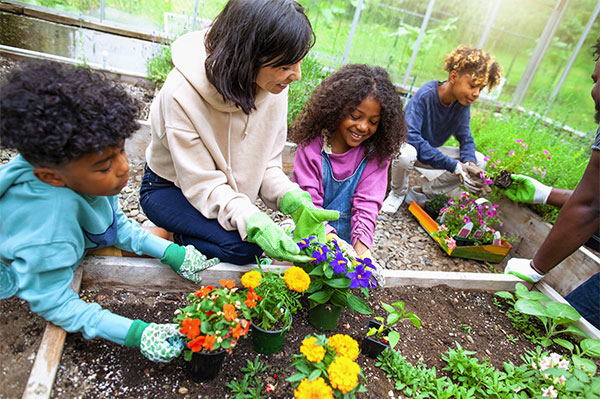Gardening Tips for Attracting Pollinators and Enhancing Biodiversity
Gardening Tips for Attracting Pollinators and Enhancing Biodiversity
Blog Article
Expert Gardening Tips for Producing a Sustainable and Eco-Friendly Garden
Starting the trip to produce a environmentally friendly and lasting yard involves a series of deliberate selections and methods that not only improve the charm of your room yet also add positively to the environment. By picking native plants that are fit to your region, you can reduce dependence on chemical fertilizers and chemicals while offering important assistance to local wild animals. Furthermore, including water preservation methods and natural gardening approaches plays a critical function in maintaining a healthy ecosystem. To discover more sensible methods and skilled insights, let us check out the key aspects that specify an ecologically aware garden.
Choose Native Plants
Selecting native plants for your yard is a basic action toward accomplishing sustainability. Additionally, native plants typically call for much less water when established, adding to much more efficient water use.
Past their sensible advantages, native plants play an essential function in supporting neighborhood biodiversity. They give necessary habitat and food sources for indigenous wildlife, including pollinators such as butterflies, bees, and birds. This promotes a balanced ecosystem, which is essential for the health and wellness of your garden and the surrounding setting.

Implement Water Preservation
Executing water conservation methods is vital for keeping a sustainable garden. Effective water use not just reduces the environmental influence but likewise ensures that plants get adequate hydration without waste. One efficient approach is to make use of drip irrigation systems, which deliver water directly to the plant roots, lowering dissipation and drainage. This targeted technique can substantially decrease water usage compared to typical lawn sprinklers.
In addition, mulching is a useful technique for preserving water. By using a layer of organic mulch, such as wood chips or straw, around the base of plants, gardeners can decrease dirt dissipation and preserve constant wetness levels. Mulch also helps manage dirt temperature and suppresses weed development, more adding to plant health.
Rainwater harvesting is an additional lasting technique. Installing rain barrels or various other collection systems allows gardeners to capture and keep rainwater, which can later on be made use of throughout completely dry periods. This not just saves community water yet likewise offers an all-natural, chemical-free source for irrigation.
Finally, selecting drought-tolerant plant varieties can dramatically lower water demands. These plants are adapted to grow in low-water conditions, making them perfect for eco-friendly yards. gardening tips. Executing these water conservation approaches will cultivate a durable, lasting garden
Use Organic Gardening Approaches

Pest monitoring in an organic yard counts on integrated insect administration (IPM) methods. These consist of encouraging advantageous insects, using natural predators like ladybugs and lacewings, and executing crop rotation to disrupt pest life cycles. Companion planting, where certain plants are grown with each other to push back parasites or attract beneficial insects, is another effective technique.
Weed control is managed via mulching and hand-operated elimination, as opposed to relying on herbicides. Mulch not just subdues weeds however likewise conserves moisture and boosts dirt wellness as it damages down. Organic composts, such as straw, wood chips, and leaves, are particularly useful.
Produce Wildlife Environments
Developing wild animals environments within your yard not only enhances biodiversity but also supports the community's equilibrium. By making rooms that draw in and sustain local fauna, you can create a growing micro-ecosystem that profits both animals and plants. Beginning by including indigenous plants, as these are well-suited to your neighborhood climate and provide important food and sanctuary for wild animals. Native plants supports a variety of insects, birds, and little mammals, adding to the ecological network.
Think about including a water attribute, such as a pond or birdbath, to supply a regular water source. Water aspects bring in a selection of species, from amphibians to pollinators, improving the yard's vigor. Additionally, setting up birdhouses, bat boxes, and insect resorts supplies safe nesting sites and motivates biodiversity.
Leave some locations of your garden see this undisturbed, enabling fallen leave clutter and navigate to these guys dropped branches to accumulate. These natural debris stacks develop environments for pests and small creatures, promoting a balanced ecological community. Stay clear of using chemical pesticides and herbicides, as they can hurt valuable wild animals and disrupt food chains. By prioritizing these sustainable methods, your garden can end up being a refuge for neighborhood wild animals, promoting environmental health and wellness and sustainability.
Technique Composting and Mulching
A vital element of sustainable gardening, composting and mulching, dramatically improves soil health and wellness and decreases waste. Unlike synthetic fertilizers, compost enhances the soil with useful microorganisms and essential nutrients, promoting a healthier yard community.
Mulching, on the other hand, entails covering the dirt surface with natural or inorganic products, such as straw, timber chips, or shredded leaves. This technique uses several benefits: it conserves dirt moisture, reduces weed growth, and moderates dirt temperature. Compost also gradually breaks down, adding natural issue to the soil and more enhancing its fertility.
To practice efficient composting, guarantee your compost heap has an equilibrium of environment-friendly products (rich in nitrogen) and brown products (abundant in carbon), preserving ample oygenation and wetness. gardening tips. Regularly turning the pile accelerates decomposition. For mulching, apply a 2-3 inch layer around plants, guaranteeing it does not straight contact stems or trunks to stop rot
Verdict

Selecting indigenous plants for your garden is a fundamental action towards achieving sustainability.In addition, integrating native plants can enhance the aesthetic appeal of your yard. These plants are adapted to thrive in low-water problems, making them excellent for environment-friendly gardens. Carrying out these water preservation techniques will promote a durable, lasting garden.
In conclusion, developing a eco-friendly and sustainable yard entails the calculated selection of indigenous plants, the adoption of water preservation strategies, and the implementation of organic horticulture approaches.
Report this page